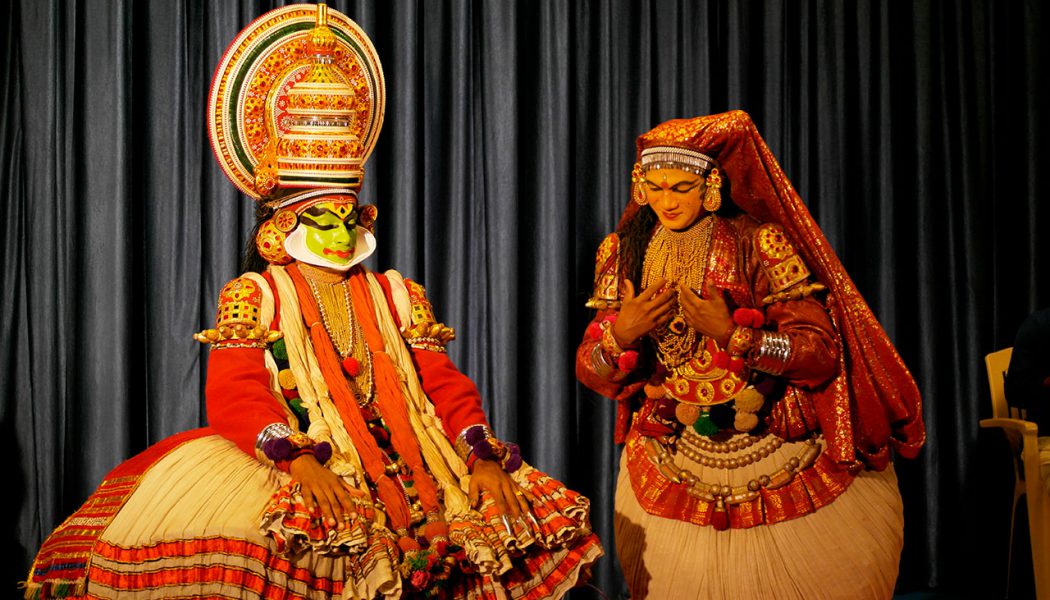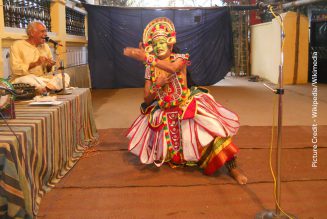Kathakali is one of the main art forms of India. It is a vibrant classical art form originated from Kerala. For more than 300 years, it is an iconic art form of Kerala. It is structured around plays called “Attakkatha” or enacted story. Stories from Indian epics like Mahabharata, Ramayana, and Shaiva Literature are enacted on the stage.
The following article is composed with information from various sources – my sincere thanks and credits to all original contributors. I have also added some information as per my knowledge about Kathakali. Hope you will find it useful in understanding the basics of Kathakali. All pictures used in this article are for illustration only. Credit goes to the original photographers and owners of the pictures.
Origin
Kottayaththu Thampuraan, Unnayi Warrier, Irayimman Thampi, Vayaskara Moos etc. are some of the major contributors of Attakkatha or the text for Kathakali. The main Kathakali plays include Kalyana Sougandhikam, Nala Charitham, Utthara Swayamvaram, Duryodhana Vadham, Bali Vadham, Santhana Gopalam, Bana Yuddham, Keechaka Vadham etc.
Kathakali is staged mostly outdoor, but also on some indoor stages. The story is enacted through gestures and facial expressions which are universally understandable. The colours of the makeup and the costumes make Kathakali distinct. It is a fusion of dance, music and act and blends aspects of ballet, opera, masque and pantomime.
History
At one time Kathakali was normally performed by men and young boys. But for few years, women also have started doing leading roles in Kathakali. The first documented woman to participate in Kathakali is Kartyayani from Tripunithura, who was part of the palace ensemble.
The wealthy and powerful in the society have shown great interest in Kathakali, which made it popular. At one time, owning a Kathakali troupe was a matter of pride. The basic elements of Kathakali are Natya (expression), Nritta (dance), Nritya (enactment), Geetha (song) and Vadya (instruments). The performance is done in front of a big Nilavilakku (oil lamp).
The artists undergo rigorous exercises as part of the training process. Body massage using the feet (Chavitty Uzhichil) is mandatory for the artists. This was one of the reasons why woman artists were not welcomed to perform Kathakali. Kathakali incorporates movements from ancient Indian Martial Arts called Kalari Payattu.
Songs and Makeup
The songs used in Kathakali Performance are known as Kathakali Padams. Elements and aspects of Kathakali are originally from the Natya Shastra. The costume for Kathakali is elaborate with head dresses, face masks and vivid painting on the faces. It takes several hours for the makeup, especially the face painting.
There is an accepted code for the makeup which helps the audience to easily identify the characters. Gods, goddesses, saints, demons and animals are characters of the story. The seven basic types of makeup are Pachcha (green colour), Pazhuppu (ripe), Kathi (knife), Thaadi (beard/red), Minukku (radiance), Kari (black) and Theppu (basic face painting). Colours predominantly used in Kathakali are red, yellow, white, green, black and blue. The colours are extracted from natural substances and herbs with coconut oil used as a base for the mix.
Read about backstage preparations: Rahul Devakumar’s Creative Media
Colour Code
Red is the code for characters with evil streak like Ravana, Dusshashana, Hiranyakashipu etc. Kari symbolizes forest dwellers, hunters, demons/demonesses etc. Yellow denotes monks, beggars and women. Minukku is usually applied for noble, virtuous characters. Vella Thaadi symbolizes divine characters.
Head gears of various types are used by the Kathakali artists. There are some ancient families in Kerala who are specialized in making the head gears and ornaments for Kathakali.
Read more on Kathakali Koppu at: Crafting Kathakali Koppu
Choreography
Choreography is most important in Kathakali like any other classical Indian art forms. It needs years of experience before an artist can perform on stage. Actors do not utter a word on the stage. Everything is enacted by actions and mudras. Emotion and mood are expressed through facial and eye movements. The vocalists and instruments back the enactment of the story.
Nava Rasas (nine facial expressions) such as Sringara (love), Hasya (comic), Karuna (sad), Raudra (anger), Vira (vigour), Bhayanaka (fear), Bheebhalsa (disgust), Adbhutha (wonder) and Shanta(peace) and 24 main Mudras (hand signs) are used in Kathakali.
Kathakali performance has different steps such as Keli, Arangu Keli, Thodayam, Vandana Slokam, Purappadu, Melappadam, Kathaabhinayam and Dhanarashi. Normally it takes about 8 hours to present a complete story but there are plays lasting more than one day and enacted by parts.
Steps
Keli is the first part where the everyone is informed that Kathakali is about to start. Instruments like Chenda, Maddalam, Chengila, Elathalam are used in this.
Traditional Oil Lamp (Vilakku) is lighted on the stage. After this the Arangu (stage) Keli is performed using the Maddalam. This is also called Kelikkai, Suddha Maddalam or Ganapathi Kottu. Once Arangu Keli is over, the stage is covered by a curtain (thirassheela), usually held by two people at its ends.
Thodayam is supposed to be for pleasing gods. The vocalist sings songs in praise of gods with two actors in their basic makeup appearing behind the curtain.
Vandana Shlokam is sung after welcoming the audience. These are shlokas from the Aattakkatha.
Purappadu (start) is where the main character (Vesham) of the story is introduced.
Melappadam is after the Purappadu. A Song from the famous Geetha Govindam (Ashtapathi composed by Jeyadeva) is sung by the vocalist. The artists performing with instruments showcase their talent during malappadam.
Thiranokku is a stage where the anti-hero drops the curtain and the hero is exposed in full view.
The preamble of female character appearance is known as Kummi – a sort of dance.
Kathaabhinayam or Kathakali follows. There are two parts of Kathaabhinayam, the Cholliyaattam and Elakiyaattam. In Cholliyaattam, the artists enact with Mudraas (hand signs) in accordance with the songs. Elakiyaattam is where the actors improvise and enact the story. This is the Kathakali.
Dhanaraashi is the last part of the performance. This is done in praise of the god.
The show has breaks in between at designated timings.
Music is the central part of Kathakali performance. It sets the mood and triggers emotions according to the scene being enacted by the artists. The vocalists are experienced singers trained to sing various melodies. They not only deliver the verses, but also help setting the context and expressing the inner state of the character by modulating their voice.
See more at: Kathakali, the traditional classical art
Renowned Poet Vallaththol Narayana Menon and Manakkulam Mukunda Raja took the initiative to set up Kerala Kalamandalam, a centre of excellence for classical art forms at Cheruthuruthy in Thrissur. Since then Kerala Kalamandalam works for the revival of this great art form. Kerala Kalamandalam offers various courses from high school to doctorate levels.
Famous Kathakali artists include…
Kalamandalam Gopi Ashan, Sri Vasu Pisharody,Guru Gopinath,Sri Chengannoor Raman Pillai, Sri Margi Vijayakumar
Sri Kalanilayam Balakrishnan, Sri Kalamandalam Haridas (Musician), Sri Kalamandalam Kesavan
Read more about Kathakali Artists: Famous Kathakali Artists
Major Kathakali Centres in Kerala
1 Kerala Kalamandalam, Cheruthuruthy, Thrissur District.
2 P.S.V. Natyasangham, Kottakkal, Calicut District.
3 Unnayivarrier Smaraka Kalanilayam, Iringalakkuda, Thrissur District.
4 Gandhi Seva Sadanam, Pathirippala, Palakkad District.
5 Cochin Cultural Centre, Cochin, Ernakulam District
6 Art Kerala, Valanjambalam, Ernakulam District.
7 Margi, Thiruvananthapuram, Thiruvananthapuram District.
8 R.L.V. Thripunithura, Ernakulam Dt
Pictures Credit: Kumana Natesan, Krishnakumar Unni, Sourabh Sheganonkar, Mark Harbold, Purnendu Singh, Shalini Satish and Burmese Tiger Trap.
Video: Nala Charitham Onnam Divasam (Story of Nala, 1st Day)
Video: Nala Charitham Randam Divasam (Story of Nala, 2nd Day)

